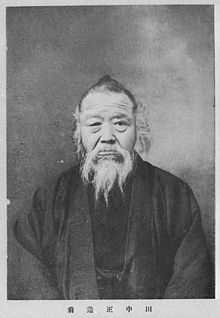Shōzō Tanaka
Shōzō Tanaka (田中 正造, December 15, 1841 – September 4, 1913)[1] was a Japanese politician and social activist, and is considered to be Japan's "first conservationist."[2] He was born in the village of Konaka in present-day Sano, Tochigi Prefecture, and was the son of the village headman. In 1857, he became headman after his father and served for twelve years.[3]:113 In 1879, he founded the Tochigi Shimbun, a periodical in which he discussed human rights and contemporary issues.[4]

Tanaka became a member of the Tochigi Prefectural Assembly in 1880, and its Chairman in 1886.[1] In the general election of 1890, the first ever held in Japan, he was elected to the House of Representatives as a member of the Rikken Kaishintō, a liberal political party.[1]
Tanaka is best known for his actions in connection with the pollution caused by waste from the Ashio Copper Mine.[5] Starting from the mid-1880s, rivers near the mine became highly polluted and in 1890 a large flood carried poisonous wastes from the mine into surrounding areas.[6] Tanaka took the cause to the National Diet, but his efforts to publicise the pollution met with little success.[3]:115 In 1900, villagers in the valley of the Watarase River, downstream from the mine, planned a mass protest in Tokyo, but were rebuffed by government troops and forced to disperse. In 1901, Tanaka resigned from the Diet to deliver an appeal directly to Emperor Meiji.[5][7] In 1911, the Diet passed the Factory Law, Japan's first law to address industrial pollution.[7]
Tanaka was a supporter of local autonomy and the primacy of agriculture.[3]:112 He spent the rest of his life developing his own environmental philosophy and encouraging villagers to protest against various construction projects.[2] After leaving the Diet he lived in Yanaka village, now a district of the city of Sano, until his death by stomach cancer in 1913.[4]
References
- ↑ 1.0 1.1 1.2 "Tanaka, Shozo". National Diet Library, Japan. Retrieved November 8, 2013.
- ↑ 2.0 2.1 Robert Stolz. "Remake Politics, Not Nature: Tanaka Shozo’s Philosophies of "Poison" and "Flow" and Japan’s Environment". The Asia-Pacific Journal. Retrieved November 8, 2013.
- ↑ 3.0 3.1 3.2 Wray, Harry; Conroy, Hilary (1983). Japan Examined: Perspectives on Modern Japanese History. University of Hawaii Press. ISBN 9780824808396. Retrieved November 8, 2013.
- ↑ 4.0 4.1 "田中正造" [Shōzō Tanaka]. Nihon Daihyakka Zensho (Nipponika) (in Japanese). Tokyo: Shogakukan. 2013. OCLC 153301537. Retrieved 2013-11-08.
- ↑ 5.0 5.1 Mari Yamaguchi (November 7, 2013). "Anti-nuclear Japanese lawmaker attacked from all sides for handing letter to Emperor Akihito". Associated Press. Retrieved November 8, 2011.
- ↑ Kichiro Shoji and Masuro Sugai. "The Ashio Copper mine pollution case: The origins of environmental destruction, Ch. 1, Sec. II". United Nations University. Retrieved November 8, 2013.
- ↑ 7.0 7.1 Imura, Hidefumi (2005). Environmental Policy in Japan. Edward Elgar Publishing. p. 18. ISBN 9781781008249. Retrieved November 8, 2013.
|